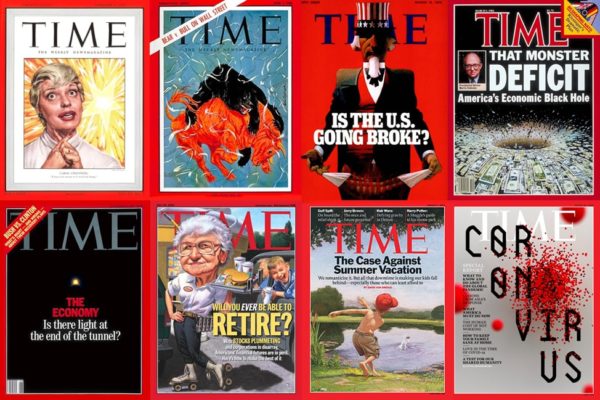“Could troubles abroad lead to an economic recession?”
“Shares of your favorite stock plummet before the opening bell sounds.”
“The DOW drops 500 points to the lowest it’s been in months.”
Do any of these news headlines sound familiar? When the media is telling us the stock market is in trouble, it’s natural to ask ourselves, “Is it time to get out before I lose all my money?” Investors have asked themselves this question every time the stock market has struggled for years and years.
In fact, in 1979, BusinessWeek published a cover story titled “The Death of Equities: How Inflation Is Destroying the Stock Market.” The magazine cover featured a stock certificate folded into a paper airplane — crashing. The articles urged readers to pull out of the stock market because stocks were no longer a worthy investment.
“The Death of Equities” brought up some valid questions: When the stock market takes a hit, should we panic? Should we get out while we can, or play the long game? Forty years after the article was published, investors still ask these questions.
A Quick Summary of “The Death of Equities”
“The Death of Equities” addressed the elephant in the room (at the time). Inflation was rising quickly, and the stock market couldn’t keep up. The author, Barry Ritholitz, said the market wasn’t sustainable at this rate. He encouraged investors to pull their money out of the stock market and invest it in something else, such as bonds or even diamonds!
To Ritholitz’s credit, pretty much everything he wrote about the economy of 1979 was true. Yes, inflation was rising aggressively, and the stock market was struggling. But his advice was flawed. He thought the stock market as he knew it was coming to an end. But he was dead wrong.
Problems with “The Death of Equities”
For a few years, the ideas from “The Death of Equities” seemed to hold up. Inflation continued to increase, and share prices continued to struggle.
Three years after the article came out, the market crashed. Then, it began an impressive resurgence.
The S&P 500 represents around 70% of the market, so you can gain a solid understanding of how the market is performing as a whole by looking at this index. On August 13, 1979 (the day the piece was published), the S&P 500 closed at 107.42 points. Forty years later, on August 13, 2019, the S&P 500 closed at 2,882.44 points. That’s an increase of almost 2700%. Not too shabby, right?
During this time, inflation only multiplied by around 3.5 times. Not nearly as quickly as the S&P 500.
Yes, the stock market was struggling against inflation in 1979. But in the long run, inflation did not outrun the stock market. BusinessWeek made an error by assuming that because things were bad at that moment, they would stay bad.
This is a common misconception among investors. But analysts have learned a lot since “The Death of Equities” came out. They’ve learned that staying optimistic is the way to go and that over worrying is for the birds.
Should You Worry About the Stock Market Now?
Trade wars. Actual wars. Diseases. Natural disasters. Plenty of factors other than inflation can cause the stock market to take a spike downward. And it’s a scary feeling.
But here’s what we can learn from the mistakes BusinessWeek made with “The Death of Equities”: Things may be bad now, but that doesn’t mean they’ll be terrible forever. Don’t sell all your shares and swear off the stock market just because the market has hit a rocky stretch. Think about the long-term situation, not the short-term, and seek counsel from professionals rather than act out of fear.
When Ritholtz wrote “The Death of Equities” in 1979, America was facing many of the same problems as it has faced in the 21st century. The United States was going through a war (the Cold War). There was political strife. Unemployment rates were affecting the workforce. But the country got through those hard times, and so did the stock market.
Remember, history often repeats itself. Next time you find yourself thinking this is the real thing and your investments are actually doomed … take a deep breath. When it comes to the stock market, optimism isn’t naive. It’s realistic.
Feel free to contact us to discuss the stock market and ways to stay calm when the stock market takes a turn for the worse.













